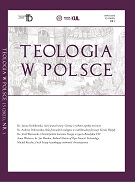Zamierzeniem autora artykułu jest ukazanie Maryi jako Tej, która stanowi istotne oparcie dla osób niepełnosprawnych, pomaga im przezwyciężyć poczucie beznadziejności, przełamać osamotnienie, podjąć zmagania o życie wieczne. Patrząc na Maryję, możemy dostrzec sens życia niezamykający się w pełnej sukcesów działalności zawodowej. W osiągnięciu tego celu ma pomóc spojrzenie na inspirowane wiarą chrześcijańską przejawy polskiej myśli od XIX do początku XXI wieku, takie jak podręczniki mariologii, artykuły teologiczne, kazania, homilie, rozważania, świadectwa świętych czy wybitne dzieła literatury. Rzecz jasna, praca nie rości sobie pretensji do uwzględnienia wszystkich źródeł z tego okresu. Chodzi w niej o pokazanie głównych elementów podejmowanej problematyki.
SUMMARY
MARY AS THE MOTHER OF PEOPLE WITH DISABILITIES
The Virgin Mary, as the one present next to the cross of her Son, shows compassionate care to people with disabilities who have limited possibilities of working and living independently. She gives them her strength, uplifts them, protects from doubt, loss of hope and temptation of despair. She shows them the way out of loneliness. Mary cares for the eternal salvation of the people with disabilities. At times the blind, the deaf, the mute, the lame and the paralyzed regain their health. She calls on the disciples of Christ to show solidarity, care and attention to people with disabilities. She is a Mother whom it is worth to know and love. She shows the people with disabilities a path of prayer and offering one’s suffering for others. She helps them to see the beauty and meaning of their life. Pilgrimages to Marian shrines are a special way to encounter the Virgin Mary.
Ostatnia aktualizacja: 11.10.2019, godz. 09:07 - Marcin Walczak































